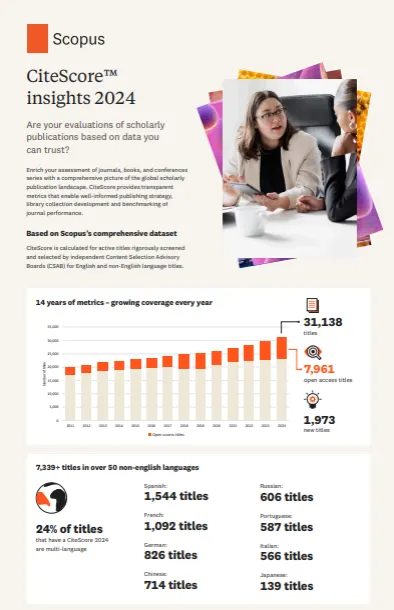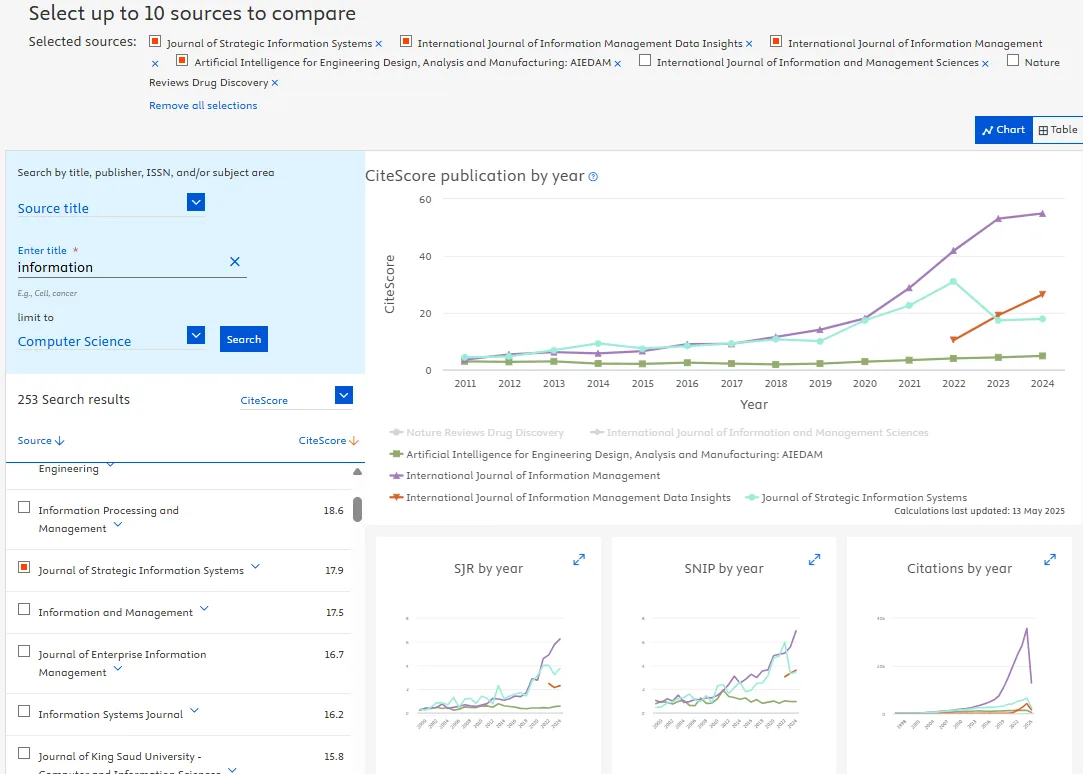CiteScore explainer video

Watch now
|
Explore the benefits of using CiteScore metrics for evaluating scholarly publications and view how CiteScore works.
Unfortunately we don't fully support your browser. If you have the option to, please upgrade to a newer version or use Mozilla Firefox, Microsoft Edge, Google Chrome, or Safari 14 or newer. If you are unable to, and need support, please send us your feedback.
We'd appreciate your feedback.Tell us what you think!
CiteScore metrics enrich the evaluation of serial titles and provide transparent data to help you measure the citation impact for journals, book series, conference proceedings and trade journals. This comprehensive, clear and current system of metrics for analysis can be accessed for free on Scopus.
Powered by Scopus with active titles from 7000+ publishers across 334 disciplines, CiteScore provides transparent metrics that enable well-informed publishing strategy, library collection development and benchmarking of journal performance. More titles are being frequently added and tracked, with the freely available metrics.

Watch now
|
Explore the benefits of using CiteScore metrics for evaluating scholarly publications and view how CiteScore works.
As part of a multi-dimensional array of metrics, CiteScore metrics can help to:
Discover titles to create reading lists
Acquire evidence about title relevance to and performance in a field
Check the performance of one or more titles and decide where to submit an article for publication
Analyze the citation impact of titles to be used in library acquisition decisions, or for determining publication/portfolio strategies
Determine research impact in a given field
Additionally, publishers and editors can monitor the performance of a title or a portfolio of titles, as well as monitor publishing trends among competing titles.

CiteScore metrics 2024 insights
Download infographicElsevier supports responsible research assessment. When used correctly, research metrics – together with qualitative input – give a balanced, multi-dimensional view for decision-making.
Always use both qualitative and quantitative input into your decisions.
Always use more than one research metric as your quantitative input.
Learn more about how Elsevier supports responsible research assessment
Whether you want to decide where to submit your article for publication, evaluate your library collection or track the performance of your journal portfolio, comparing sources in Scopus is also freely available for you to use.

A view of comparing up to 10 sources
Fair comparison among journals | Focus on primarily peer-reviewed publications only | Exclude influence of non-peer reviewed article types | Easier access to underlying data |
Robust, stable assessment of journals | Within the journal citation impact, older articles get their fuller citation impact | More robust assessment of citations to publications after their initial publication date | Longer citation window |
Early citation impact indication for new titles (often open access) | New journals receive the first indication of their citation impact 1 year earlier (compared with the old CiteScore methodology) | More journals can be compared globally | Helps new journals demonstrate the citation impact of their publications sooner |
Complies with the responsible metric principles of the Leiden Manifesto and DORA
(among others) | Principle 4: Data collection and analytical processes should be open, transparent and simple | Principle 5: Titles evaluated must be allowed to verify data and analysis The underlying CiteScore data are freely available for verification purposes without a subscription to Scopus | Principle 10 of the Leiden Manifesto: Indicators must be scrutinized regularly and updated if necessaryCiteScore was launched in 2016; by 2020, we had revised the methodology based on expert and user feedback |
Get free access to CiteScore metrics on Scopus.
Learn more about all the available Scopus metrics.
CiteScore metrics are embedded in our SciVal, Pure and ScienceDirect platforms, as well as available for free via Elsevier’s Journal Insights.
25+ publishers including Taylor & Francis, Elsevier, Oxford University Press, MDPI, BMJ Journals, SAGE, Walter de Gruyter, Hindawi, Emerald and IEEE, display CiteScore on their journal homepages.
As a publisher, are you interested in adding a CiteScore to your site? See our documentation and available APIs.
